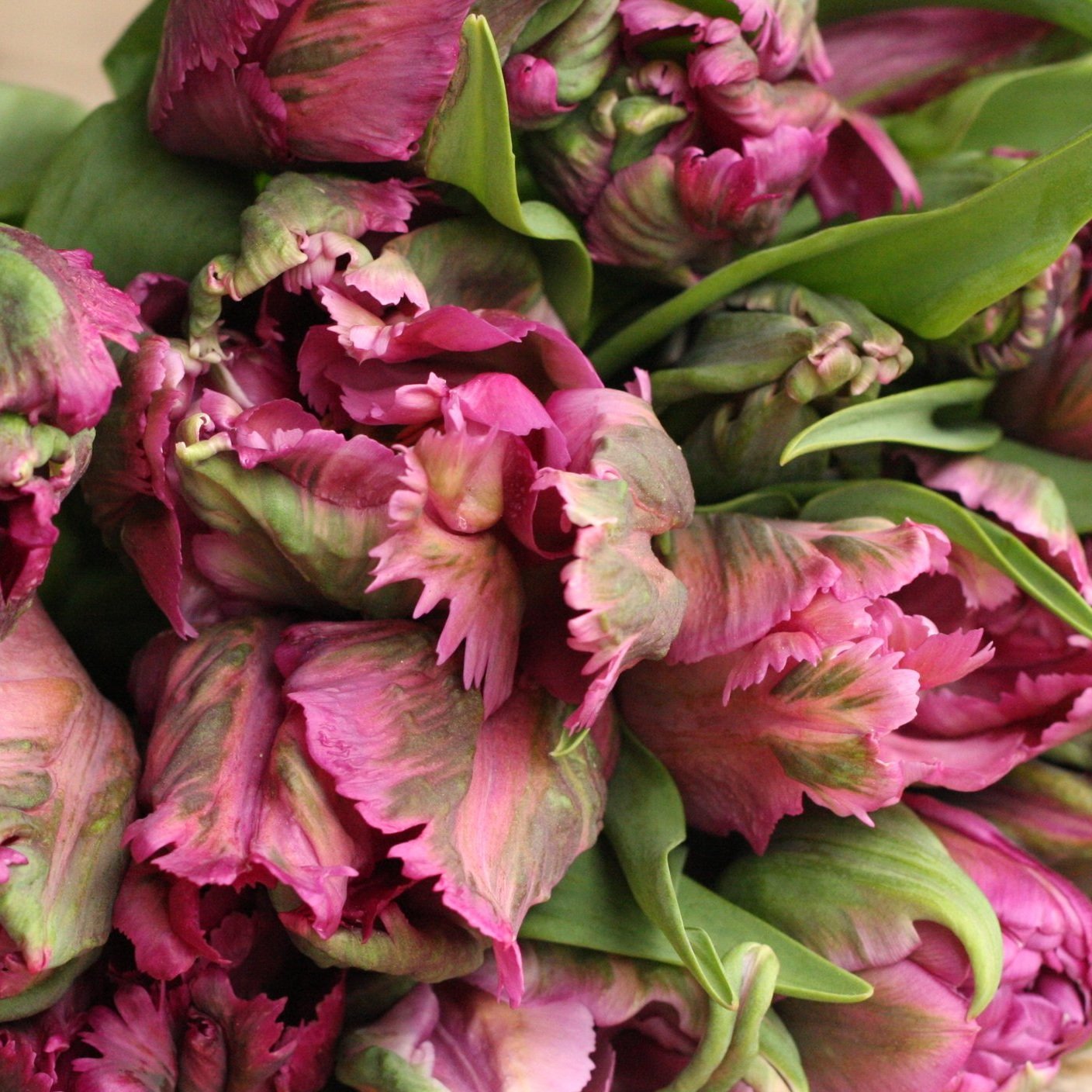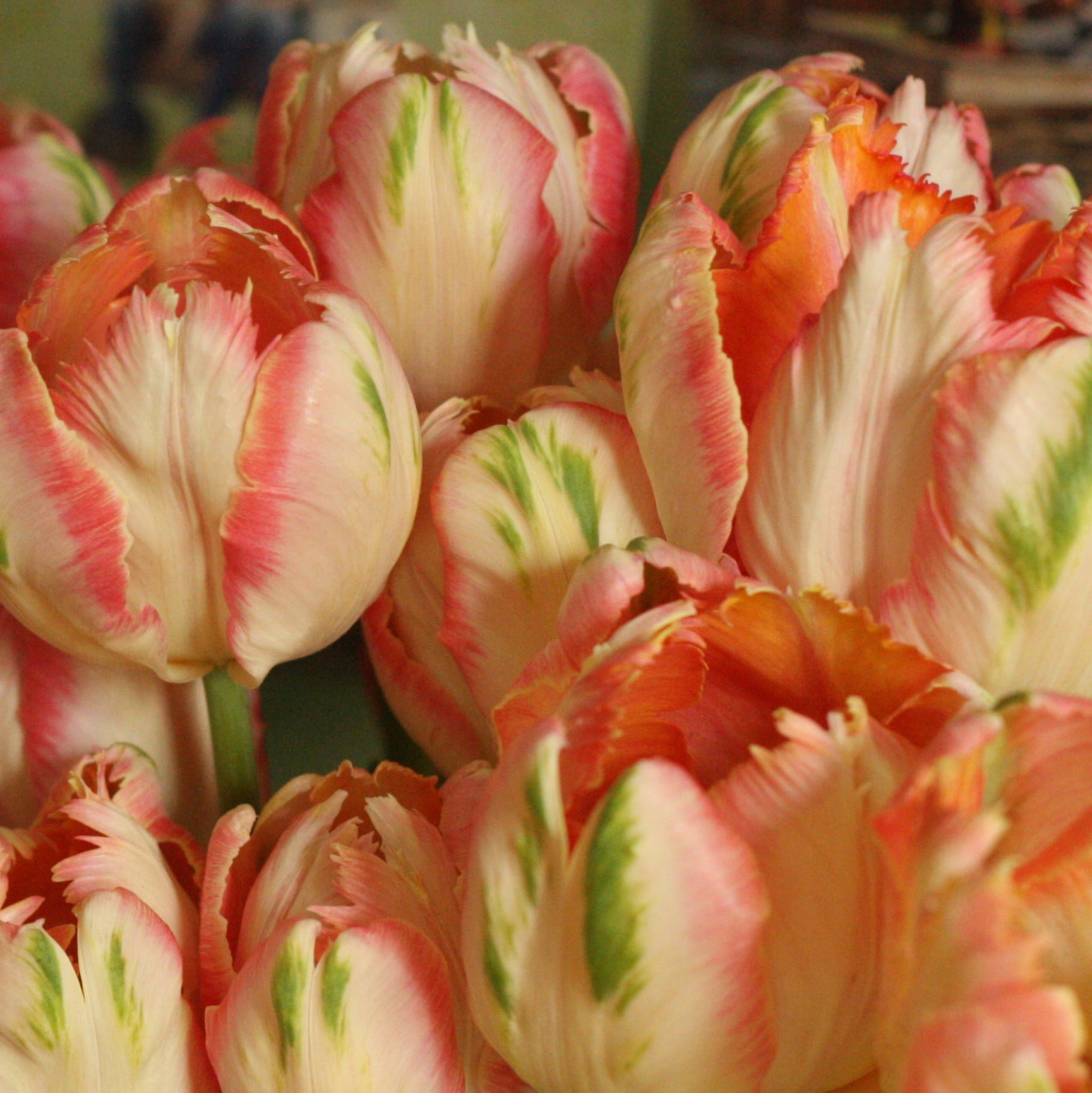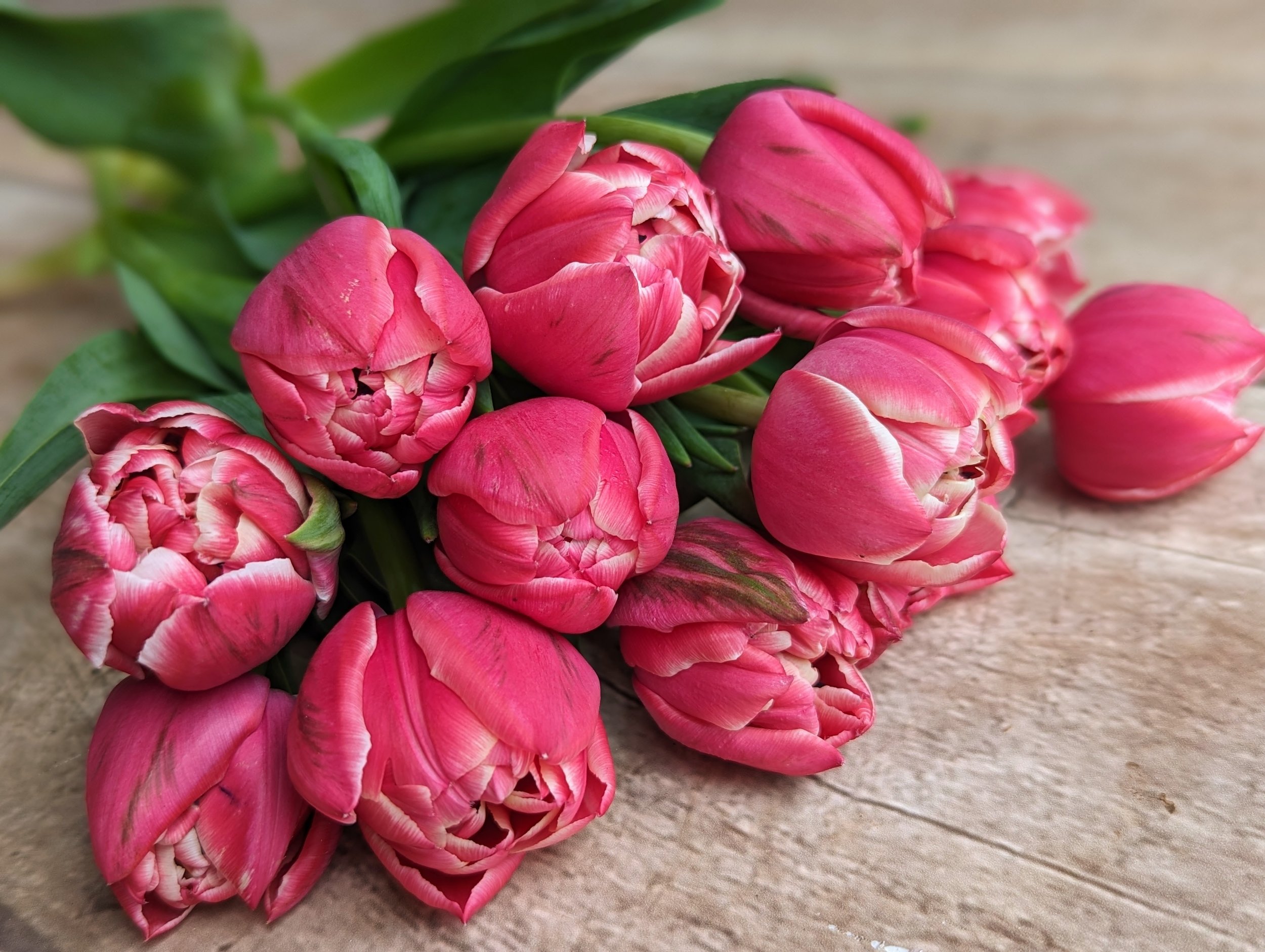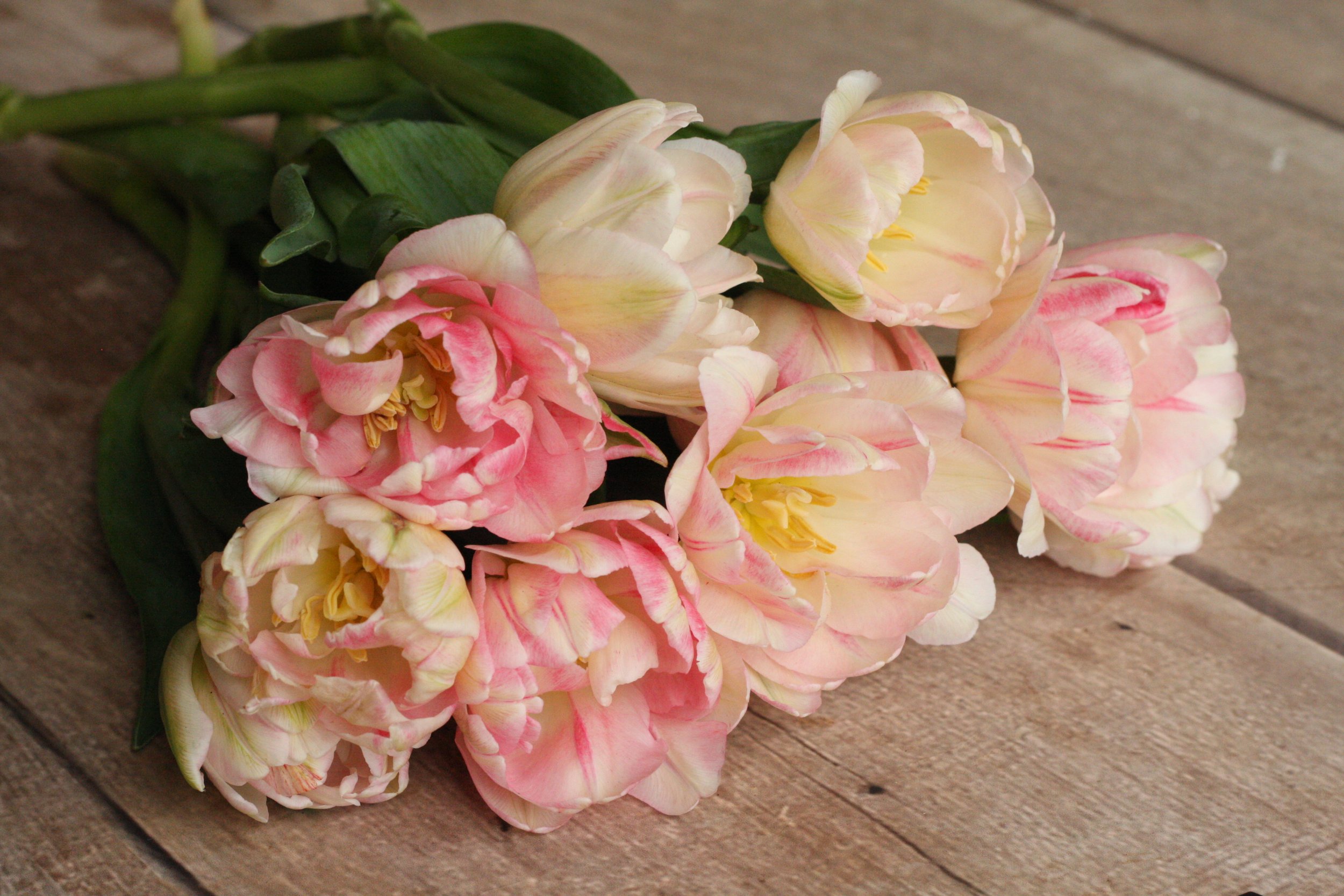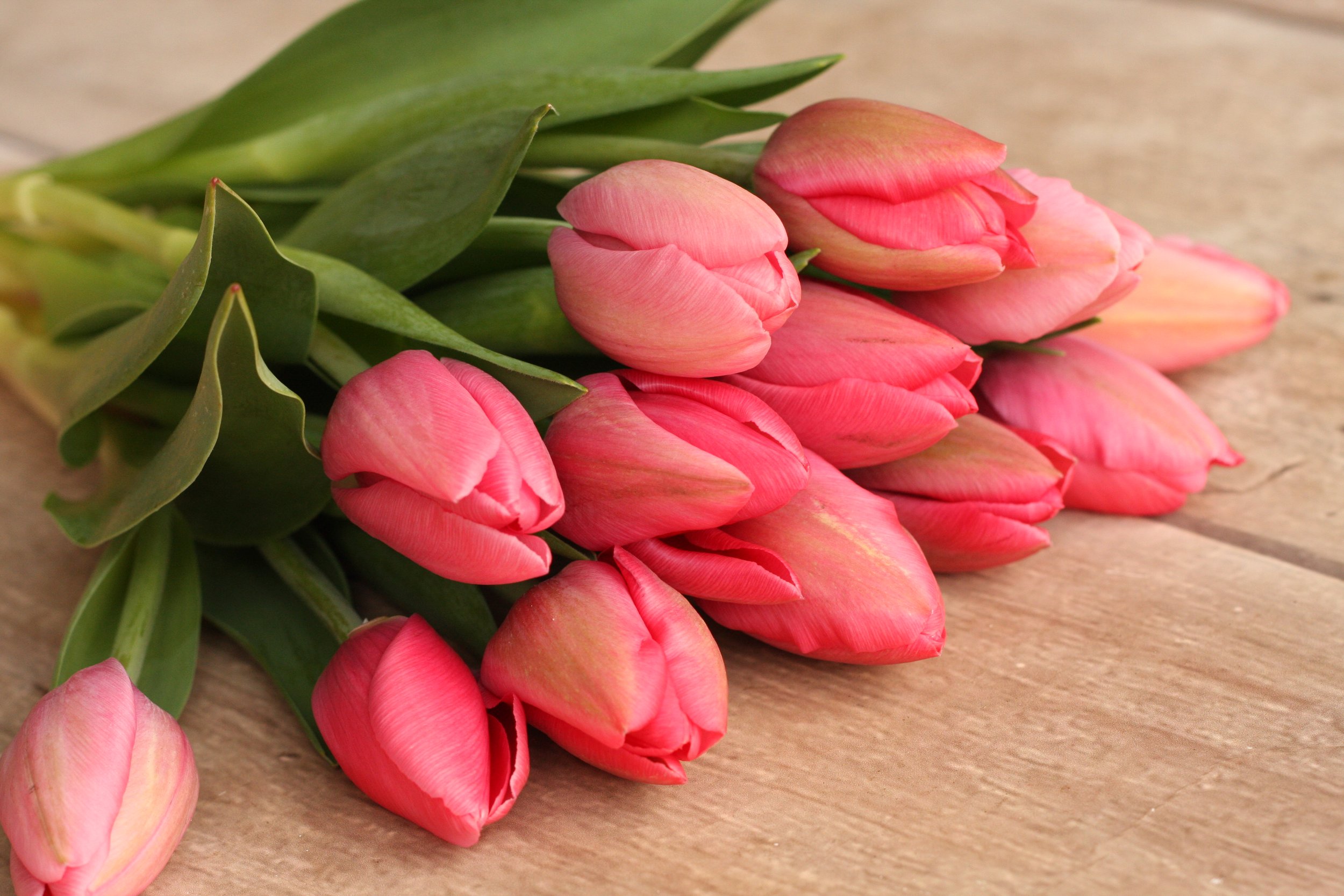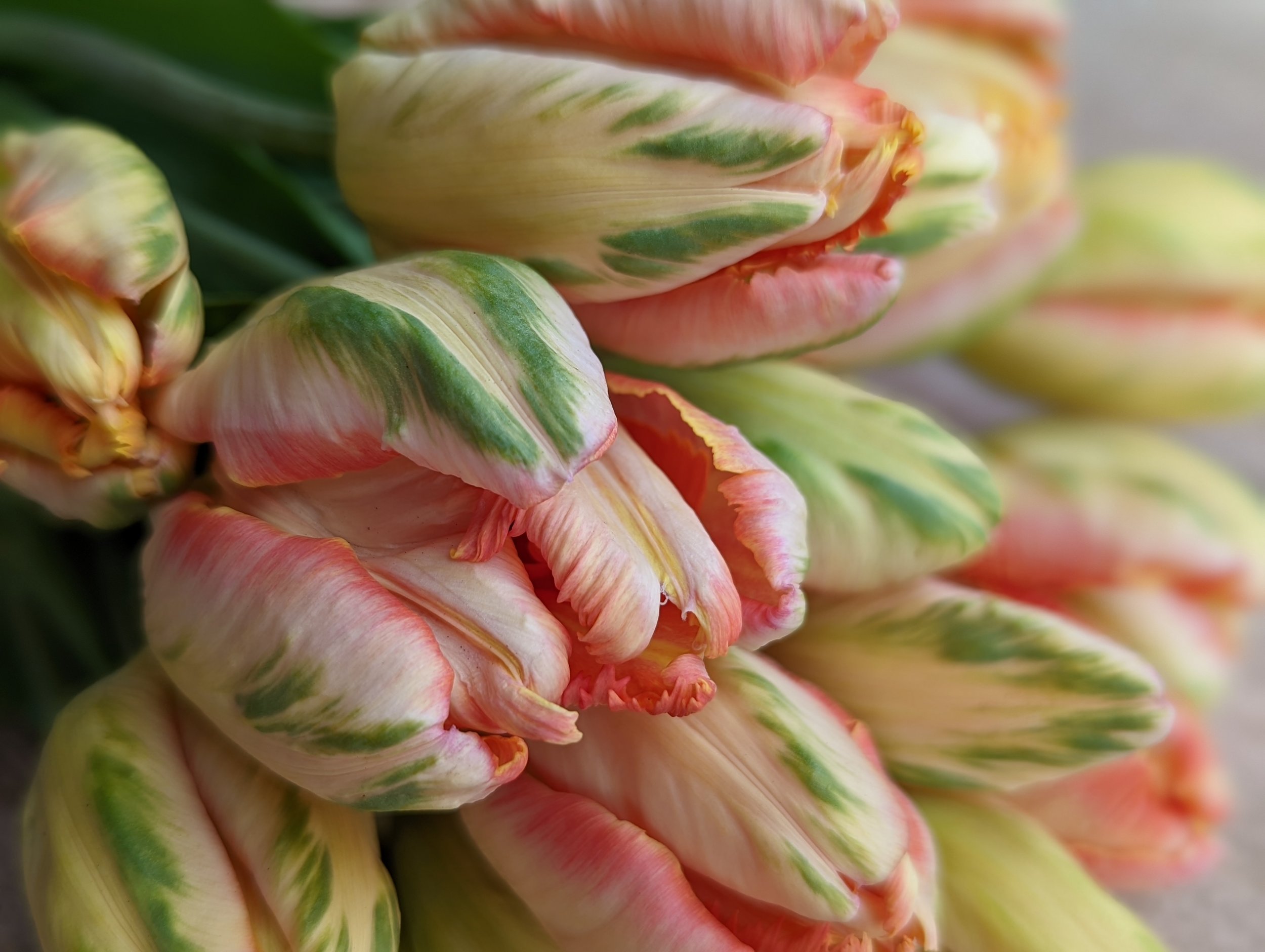How to Grow: China Asters
How to Grow: China Asters
Pronunciation: ka-LIS-te-fus chin-EN-sis
China Asters (Callistephus chinensis) are a lovely addition to the cutting garden.
There are many types of Asters, including popular cultivated and wild native Perennial types. However, here we are going to discuss only the Annual blooming China Asters (Callistephus chinensis).
“Optimo Alpha Light Blue” and “Optimo Red”
There’s a reason why China Asters are so popular as a cut flower. They are sturdy, tough and long-lasting in the vase. They also come in wide range of colors and shapes. Some of them even resemble fluffy Peonies!
However, China Asters can be a bit tricky to grow, since they are “day length” sensitive and must be planted at juuuuust the right time to achieve good stem length (more about that later).
They also can be susceptible to some difficult disease issues, depending on where you live.
Because of these challenges, I categorize China Asters as best for “Experienced Growers”.
On our farm, we love growing a variety of China Asters as both a Focal Flower (large flower that is the focus of a bouquet) and Filler Flower (medium-sized flowers that complement the Focal Flowers).
Some China Asters will produce 8-12 large flowers on long stems, while others may produce dozens of smaller flowers on a “spray” type stem (one main stem with multiple flowers).
“Optimo Red” and “Optimo Alpha Light Blue”
Let’s look at the Pros and Cons of growing China Asters for cut flower use.
PROS
They come in a multitude of colors, sizes and types.
They are very sturdy plants.
The flowers are durable and not easily damaged by handling.
The flowers “hold” for a long time in the field, giving you a long window of opportunity to harvest the blooms.
They often produce multiple blooms per plant.
They have an excellent vase life of 7-10 days with proper harvest and care.
CONS
They must be planted at a specific time due to day-length sensitivity. If this “window of opportunity” is missed, the plants will likely bloom on short, unusable stems.
They are not a good candidate for “succession planting” since they perform best when planted at a specific time.
They are very susceptible to Aster Yellows disease, which is spread by leafhoppers and thrips. If you live in an area where Aster Yellows disease is common, you may have a difficult time growing healthy plants (this is a BIG challenge for us!).
They can experience “Aster Rot”, a fungal infection that causes the plant to rapidly wilt and rot.
CHOOSING SEEDS
There are lots of different types of China Asters you can try, so choose ones that have colors and shapes that please you.
Be sure to look for varieties that reach a minimum of 24” tall. Many China Asters are sold for bedding plant/landscape use and won’t be tall enough for cut flower use.
The following China Aster series are a great choice for cut flower use:
Azumi X
Bonita
Matsumoto
Optimo
Tower
“Optimo Red”
Here are a few of my favorite China Asters to grow for cut flower use:
Azumi X “Rose”
Tower “Chamois”
“Optimo Alpha Light Blue”
HOW TO SOW
China Asters are easy to grow from seed in trays. Bury seeds about ⅛ deep and keep seeds moist and warm until germination occurs in 10-14 days.
Transplants or Direct Sow?
China Asters should be transplanted. Direct sowing is not recommended.
Sow seeds indoors 6-8 weeks before your Average Last Spring Frost. They should be transplanted out after the threat of frost when the soil is warm.
It’s important to transplant the seedlings promptly so they can grow as much as possible before the Summer Solstice occurring around June 21(ish) in the Northern Hemisphere. As the days shorten after the Solstice, the plants begin to set their blooms and the stems will not grow much taller.
Ideally, you want the plants to grow as tall as possible before the Summer Solstice to get the longest stems possible.
“Succession Planting” is not recommended for China Asters, since transplanting additional successions later in the season will result in short, unusable stems.
“Optimo Alpha Light Blue”
PLANT SPACING
Most varieties can be grown at 6-12” spacing. We usually grow at 9” spacing, but could grow most varieties closer for more efficient use of space. Closer spacing will encourage longer stems as the plants compete for light.
“Bonita Shell Pink”
GROWING ON
If you live in an area where Aster Yellows disease is a problem, I recommend covering the seedling with insect netting IMMEDIATELY after transplanting. You can find my favorite insect netting and clamps HERE. This will help to protect the plants from leafhoppers and thrips.
If the plants DO show signs of Aster Yellows or Aster Rot, remove them immediately and throw them away (do not compost). Be sure to rotate where you plant China Asters each year to help prevent disease issues.
To reiterate, it’s important to transplant the seedlings promptly so they can grow as much as possible before the Summer Solstice occurring around June 21(ish) in the Northern Hemisphere. As the days shorten after the Solstice, the plants begin to set their blooms and the stems will not grow much taller.
Ideally, you want the plants to grow as tall as possible before the Summer Solstice to get the longest stems possible.
Fertilize and water the plants regularly when the plants are young and actively growing. Once the buds begin to form, back off on feeding but continue watering.
The plants are sturdy but still benefit from netting or support to keep the stems straight.
Pinching is generally not necessary or recommended, however some types may benefit from it. If desired, you could experiment by pinching a few plants and comparing them to unpinched plants. Note: This is how I discovered Optimo series does NOT like to be pinched! ;)
STAGE OF HARVEST
China Asters bloom in mid to late summer (usually around mid-August on our farm in Michigan). Unlike other flowers, China Asters have a long “harvest window”, so there is no rush to harvest them.
Harvest when the outside florets begin to open. Single stem types can be harvested one stem at a time, while spray types do best as a whole plant harvest (cut the entire plant off at the ground).
“Tower Chamois”
POST-HARVEST CARE
China Asters require no special treatment after harvest.
QUESTIONS?
Ask them here and I’ll get back to you!
Ready for more?
If you’re serious about growing the garden of your dreams this year, register for my online course, “Backyard Cutting Garden 101”. You’ll find everything you need to plan, grow, harvest and arrange your stunning blooms. I can’t WAIT to help you grow! Click on the button below for all the details.
How to Grow: Cosmos
Dreamy. Whimsical. Romantic. Swoon-worthy. Delightful.
How to Grow: Cosmos
Pronunciation: koz-mose
Dreamy. Whimsical. Romantic. Swoon-worthy. Delightful.
Cosmos are all this and more. Because they are such a common and easily grown flower, I think they are often overlooked and underestimated for their value as a cut flower. They are not necessarily big or bold or flashy… but they are still one of my favorites!
They are reliable, productive and simple to grow. The more you cut them, the more they produce. As a bonus, they really shine in late summer, when some of the other flowers are starting to get tired. Every cutting garden should have some Cosmos!
PROS
They come in a variety of colors and sizes.
They are very easy to grow.
The plants are productive for a long period of time (if harvested regularly).
They are a beautiful addition to bouquets.
They have a good vase life of about 5 days, if harvested at the proper stage.
CONS
They are susceptible to Powdery Mildew. This usually does not affect the blooms, but eventually the plant will die.
Deadheading (removing old blooms) can be difficult to keep up with! If plants are not regularly harvested or deadheaded, they will stop blooming.
“Afternoon White” Cosmos
“Kiiro” Cosmos
CHOOSING SEEDS
Nearly every type of Cosmos can be used to cut flower use, but there are some varieties that have been bred specifically for cut flower use, rather than ornamental use.
Some Cosmos have “single” petals, while other are “double” petals. Some Cosmos even have petals that look like cupcake liners!
Most Cosmos grow quite tall, often reaching 4’ tall, but recently new shorter varieties have been introduced as well. Make sure you purchase varieties that reach at least 24” tall.
Cosmos bipinnatus is the class of Cosmos that includes the Cosmos you are likely familiar with, in shades of pink, white, magenta and burgundy. However, Cosmos sulphureus, know as “Sulfer Cosmos”, are another great addition to the cutting garden. They come in shades of bright yellow and orange.
Here are a few of my favorite Cosmos to grow for cut flower use:
“Bright Lights” (Sulfer Comsos)
“Double Click” Series (all the colors are beautiful, but I especially like the “Double Click Bicolor Pink”)
“Tip Top Picotee” (beautiful bicolor blooms)
“Xsenia” (gorgeous color, stems are short)
“Versailles” (classic, sturdy variety bred specifically for cut flower use)
HOW TO SOW
Cosmos are a summer-blooming flowers. They should be planted after your last spring frost.
Transplants or Direct Sow?
Cosmos are versatile and can be transplanted or direct sown.
Transplants are fine, but make sure to start the transplants only about 3-4 weeks before planting outside. Larger, older transplants tend to be “root bound” and may be permanently stunted in their growth and vigor.
Personally, I find Cosmos grow faster, are more productive and healthier when they are direct sown. You might as well save yourself some time and space, and simply direct sow the seeds!
Transplants/seeds should be spaced at about 12” apart.
GROWING ON
After the transplants are established and growing, it’s helpful to “pinch back” the plants when they are about 8”-10” tall. To pinch, simply use clippers to remove the top of the plant, only leaving 2-3 sets of leaves behind. I know this seems counterintuitive and you probably just freaked out, but trust me!
Plants that are pinched are more productive than plants that are not. Experiment for yourself - pinch half the plants and leave the other half alone. The unpinched plants will bloom earlier, but the pinched plants will produce more branches.
If flowers are harvested and spent blooms are “deadheaded” (removed), the plants will continue to send up blooms until frost or cold weather arrives.
“Apricotta” Cosmos
STAGE OF HARVEST
Many people say that Cosmos don’t last in the vase… but this is because they are harvesting the blooms too late.
Once a Cosmos bloom opens, it is immediately pollinated by bees. Once pollinated, the flower quickly drops its petals so it can begin its next stage of life - forming seeds.
In order to have long lasting blooms, you must cut Cosmos BEFORE the blooms have been pollinated, looking for buds that are cracking open or just opened. The flower will open up in the vase over the next few days. When harvested at this stage, you can expect them to last about 5 days.
Below, you can see the difference between an “Unpollinated” bloom and a “Pollinated” bloom. If the bloom has been pollinated, you might as well leave it in the garden, as the petals will quickly fall off in the vase.
“Unpollinated” bloom
“Pollinated” bloom - notice the pollen scattered on the petals
Cut deeply into the plant between 2 sets of leaves, cutting stems at least 18” long. Each stem should have multiple blooms/buds, a “spray” of flowers. Deep cuts are especially important with Cosmos, as they tend to become a tangled mess if you don’t make deep cuts!
POST HARVEST CARE
Cosmos require no special treatment.
Questions?
Questions or comments? Leave them below and I’ll get back to you!
ready for more?
If you’re serious about growing the garden of your dreams this year, register for my online course, “Backyard Cutting Garden 101”. You’ll find everything you need to plan, grow, harvest and arrange your stunning blooms. I can’t WAIT to help you grow! Click on the button below for all the details.
How to Plant Tulip Bulbs
Frequently Asked Questions about planting Tulips
Let’s talk Tulips!
Each fall, we plant about 10,000 - 12,000 Tulip bulbs on our farm. The blooms (and bulbs! More about that later…) are harvested the following spring.
Since we are a cut flower farm, we only grow Tulips intended to be harvested and displayed in a bouquet or bunch.
We do not grow Tulips to be displayed in the field or landscaping (in fact, we harvest them all BEFORE they bloom).
While planting and growing Tulips for as “Landscape flower” is quite straightforward, growing Tulips to harvest as a “Cut flower” is a completely different concept and method.
Since the concept can be a bit confusing, I wrote a comprehensive Blog post about growing Tulips as a cut flower. You can READ IT HERE.
Let’s go over some of the most Frequently Asked Questions about Tulips that show up in my inbox.
When should I plant Tulip bulbs?
Tulips are planted in the fall, before the soil freezes. It’s best to wait until after the soil temperature has cooled to below 60.
For people in extreme Northern climates, this may mean planting in September or October.
For people in warmer climates, this may mean planting between October and December.
We usually plant on our farm (Michigan, Zone 5b/6a) in mid to late November.
2. I live in a warm climate. Can I grow Tulips?
It depends. Tulips need a prolonged period (about 10-12 weeks) of cold temperatures between 35-45 F (or cooler) to grow and bloom properly.
If the Tulip bulbs do not have “chill time” in the ground, they will bloom very short, down in the leaves at ground level. If you’ve ever had Tulips bloom super short, it’s likely because they were not cold enough, long enough.
Many northern regions of the USA are sufficiently cold enough, but anyone growing in Zones listed at 7 or above on the USDA Zone Hardiness Map should consider “Prechilling” their bulbs for 6-12 weeks in a beverage refrigerator before planting them out.
(Note: Do NOT store them in a fridge with fruits/veggies, as the ethylene gas from fruits/veg can harm the bulbs. A wine or beverage fridge works best)
“Prechilling” in a fridge mimics the necessary long chill period and tricks the bulbs into thinking they have just experienced winter. Instead of “wintering” in the ground, the bulbs are “wintering” in your fridge. Plant the bulbs IMMEDIATELY after pulling them out of the refrigerator.
Here’s a sample timeline for growing Tulips in warmer climates:
Oct/Nov - place bulbs in the refrigerator for 6-12 weeks
Dec/early Jan - plant bulbs in the ground
Mar/April - Tulips bloom
(Note: Prechilled bulbs should be treated as Annuals. They will likely not rebloom the following year, because of insufficient chill time)
3. How deep should I plant the bulbs?
The general rule is to plant bulbs about 3x as deep as their length. For most Tulip bulbs, this means planting around 5-7 inches deep.
4. How do I plant the bulbs?
This depends on what your end goals are for your Tulips. There are 2 main end goals:
Growing for Landscape Use (to be enjoyed in the garden/landscape)
Growing for Cut Flower Use (to be enjoyed in the vase)
If your goal is Landscape Use, use a bulb planter to plant the bulbs 4-5 inches apart. Alternatively, you can dig a trench or large hole 5-7 inches deep, place the bulbs 4-5 inches apart, then backfill the trench/hole.
If your goal is Cut Flower Use, the bulbs can be planted much closer together, nestled like eggs in a carton (not quite touching each other, but snug). This method involves digging a trench or large hole 5-7 inches deep, placing the bulbs like eggs in a carton, then backfilling the trench (or building a temporary raised bed, as explained in this BLOG POST).
Growing for Landscape Use - bulbs planted 4-5 inches apart, 5-7 inches deep
Growing for Cut Flower Use: Bulbs planted like “eggs in a carton” about 5-7 inches deep in a trench or raised bed
Tulips do best with full sun, but can tolerate partial shade.
Tulips require well-draining soil. They may rot in wet, heavy soils.
Water deeply once after planting the bulbs. Water moderately in the spring if the soil is dry. During the blooming season, water every 3-5 days if there is no rainfall.
5. How do I keep critters from eating my bulbs?
I feel your pain. The first time I planted 125 Tulip bulbs, the next spring I discovered voles had devoured 123 of the bulbs. I was devasted! It was a hard way to learn that I can’t plant Tulip bulbs without using some sort of protection.
Unfortunately, there is no foolproof method to keep your bulbs safe besides a physical barrier (completely encasing them in wire mesh). You can read THIS BLOG POST explaining the great lengths we go to our our farm to keep our bulbs safe over the winter. It is a LOT of work, but the only way we can avoid losing thousands of bulbs each year.
6. How do I keep deer and rabbits from eating my Tulips once they come up in the spring?
Again, there is no foolproof way to keep them safe besides a physical barrier (fencing). Deer will require a tall fence, while rabbits will require a fence that is sunk into the ground to prevent digging.
If this sounds like too much work, or if you have very intense deer/rabbit pressure, then perhaps growing Tulips is a not a good fit for your property. You may want to try growing more “deer resistant” spring bulbs, such as Daffodils and Allium.
7. How do I make sure my Tulips come back each year?
There are many factors to consider and it can be helpful to adjust your expectations.
Many Tulip varieties are bred to produce a beautiful bloom in their first season… and then decline in quality in subsequent years. It's advised to replace bulbs every 2-3 years for the best display.
Some Tulip varieties may perennialize, but many will not. Most climates in the USA cannot meet their needs and are not conducive to Tulip perennialization. Tulips are native to Central Asia (Turkey, Iraq, Russia) and thrive in climates that are similar - hot, dry summers and cold, wet winters. There are very few climates in North America that can mimic these conditions required for perennialization.
These 3 varieties are most likely (but not guaranteed) to perennialize if the climate is right:
Darwin Hybrid Tulips
Emperor Tulips
Triumph Tulips
Without a physical barrier to protect them, bulbs are often eaten by voles, mice, squirrels, etc.
After the Tulip has finished blooming, you can cut off the bloom at the top of the stem, but make sure to allow the rest of the stem and all the leaves to die back COMPLETELY before cleaning up the debris. If you remove the dying foliage too early, the bulb will not be able to photosynthesize and regenerate.
If you harvest the bloom for a bouquet (cut the stem away from the bulb), the bulb has lost its ability to photosynthesize and regenerate. Do NOT harvest the bloom if you want the Tulip to rebloom the following year. Tulips grown as a cut flower are treated as an Annual. I recommend growing your “Landscape Tulips” (treated as a Perennial) and “Cut Flower Tulips” (treated as Annual) separately.
8. Are there any Tulips you recommend as a cut flower?
Any Tulip can be grown and harvested as a cut flower.
However, on our farm, we prefer to grow “Double” or “Peony-flowering” types, “Parrot” types, “Fringed” types and a few select “Single” types…basically anything that doesn’t look like a standard landscape Tulip ;)
You can learn about a few of my favorite Tulip varieties for cut flowers in THIS BLOG POST.
10 Great Tulips for Cut Flower Use
Tulips are an exceptional cut flower.
10 Great Tulips for Cut Flower Use
There’s nothing quite like Tulips in the spring. After the long dreary months of winter, they are a healing balm to soul and delight to behold.
For most us, fall is the time to plant Tulips for blooms the following spring. Here on our farm, we usually try to get all our Tulips planted before Thanksgiving.
We grow our Tulips in temporary raised beds that are disassembled after the Tulip harvest is over. You can learn more about why we grow this way HERE.
When we harvest Tulips for cut flower use, we treat them as an Annual flower, not a Perennial. We harvest the entire plant, bulb and all.
They can be stored dry (with no water) in buckets or crates for about 2 weeks in our walk-in cooler before being bunched and wrapped. When we’re ready to use them, the bulbs are removed from the stems and discarded. The freshly cut stems go into cold water and they are ready to go.
It may seem odd to throw away the bulbs, but once the stem/foliage is removed from the bulb, the bulb has no way of regenerating itself.
If you want your Tulips to come back, don’t harvest the blooms. Enjoy the blooms in the garden, instead of the vase. It’s also VITAL to allow the foliage to die back naturally on your landscape Tulips. If you remove the spent flowers/foliage too early, they cannot perennialize properly.
To summarize:
1.If you want your Tulips to behave like a Perennial, DO NOT HARVEST the blooms. Allow them to grow, bloom, and die back in the garden (but please note that many Tulip varieties only bloom reliably for 2-3 seasons).
2.If you want to harvest Tulips for bouquets, treat them as an ANNUAL. You will get one bloom per bulb, per season. The bulbs are discarded/composted after harvest. New bulbs are planted each fall.
If you want to grow Tulips for cut flower use, here are a few I’ve trialed over the years and can heartily recommend!
Apricot Impression
Type: Darwin Hybrid
Height: 24 inches
Bloom Time: Mid/Late
These Darwin Hybrid-type Tulips grow impressively long stems! A classic single Tulip with clean lines and form. They bloom early and often overlap with the Daffodil season.
“Apricot Impression”
“Apricot Impression”
Apricot Parrot
Type: Parrot
Height: 20 inches
Bloom Time: Late
Parrot Tulips are fascinatingly beautiful. I love the contrasting colors on these Tulips. They’re decadent, luxurious, and unique. Many people have never seen Tulips like these before!
“Apricot Parrot”
“Apricot Parrot”
Columbus
Type: Double Early (Peony flowering)
Height: 14 inches
Bloom Time: Early/Mid
One of the earliest “Peony” type Tulips to bloom. The bright raspberry-pink blooms with white edging are a welcome treat after a long, dreary winter.
“Columbus”
“Columbus”
Foxtrot
Type: Double Mid (Peony flowering)
Height: 14 inches
Bloom Time: Early/Mid
A dreamy pale pink Tulip that pairs perfectly with “Foxy Foxtrot”. They are similar in size, height and bloom time. “Foxtrot” and “Foxy Foxtrot” complement each other beautifully (see image below)!
CLICK HERE TO PURCHASE
“Foxtrot”
“Foxtrot”
“Foxtrot” (pink) and “Foxy Foxtrot” (yellow)
Foxy Foxtrot
Type: Double Mid (Peony flowering)
Height: 14 inches
Bloom Time: Early/Mid
Foxy Foxtrot is sturdy, reliable, and long-lasting in the vase. The delicious buttery-yellow blooms, painted with streaks of warm pink, are a pure delight.
CLICK HERE TO PURCHASE
“Foxy Foxtrot”
“Foxy Foxtrot”
Tulip "Gudoshnik Double"
Type: Double Mid (Peony flowering)
Height: 24 inches
Bloom Time: Early
Each Peony-like bloom is a symphony of shades of red, coral, orange, yellow, and cream. These Tulips are exceptionally tall and attention-grabbing, in the garden or the vase.
CLICK HERE TO PURCHASE
"Gudoshnik Double"
"Gudoshnik Double"
"Mystic Van Eijk"
Type: Darwin Hybrid
Height: 22 inches
Bloom Time: Mid
The gorgeous shimmering coral pink tones are mesmerizing, like a spring sunrise. A charming Tulip, perfect for the garden or spring arrangements.
CLICK HERE TO PURCHASE
“Mystic Van Eijk”
“Mystic Van Eijk”
Parrot Negrita
Type: Parrot
Height: 18 inches
Bloom Time: Mid
If I could only grow one Tulip for the rest of my life, it would be “Parrot Negrita”. The color, the contrast, the form…. They are quite possibly the most elegant Tulip I’ve ever seen. They look as if they are straight out of a Baroque-era painting (psst… I was a Studio Art and Art History teacher before I became a farmer!).
They may look oddly shaped as they are forming buds, but trust the process. Harvest when the buds begin to swell open (pictured below). The blooms become even more stunning as they open up and age in the vase.
CLICK HERE TO PURCHASE
“Parrot Negrita”
“Parrot Negrita”
“Parrot Negrita”, ready for harvest
Sunlover
Type: Double Mid (Peony flowering)
Height: 22 inches
Bloom Time: Mid
A dose of cheery bright sunshine after the long dark winter. These huge blooms are sure to make you smile. The Peony-like blooms are a mix of assorted shades of sunny yellow and orange, with occasional streaks of glowing red.
CLICK HERE TO PURCHASE
“Sunlover”
“Sunlover”
Super Parrot
Type: Parrot
Height: 16 inches
Bloom Time: Mid
These elegant Tulips are breathtaking on their own or paired with other Parrot Tulips (I love to mix them with “Parrot Negrita” for a particularly stunning presentation). This variety has quickly become an MVP on the farm. White Tulips complement any color scheme. I can never grow enough!
CLICK HERE TO PURCHASE
“Super Parrot”
“Super Parrot”
“Super Parrot” (white) and “Parrot Negrita” (purple)
How to Protect Tulips from Voles
A full report on my “No-Till Tulips” experiment.
How to Protect Tulips from Voles
If you’ve been following along for a while, you know that voles (small little mammals, similar to mice) are a huge problem on our farm. Voles love to eat all sorts of vegetations, but bulbs are their favorite food.
My first season on the farm, I planted 125 Tulips bulbs… and the voles ate 123 of them.
My second season, I planted about 500 bulbs… and the voles 2/3 of them.
I realized this was a SERIOUS problem and I would have to find ways to outsmart the voles.
In November of 2019, my husband and I drove all the way from Michigan to Philadelphia so I could spend a day learning from Jennie Love, of Love ‘n Fresh Flowers.
I’m grateful for Jennie’s wisdom, generosity and enthusiasm. She is an inspiration to me and I love learning from her, whether it’s in person, through one of her online courses or listening to her podcast, “The No-Till Flowers Podcast”.
When I saw her “No Till Tulips” planting method in person, I was fascinated and wanted to try it myself.
The method is brilliant. Instead of digging individual holes for each bulb or a giant trench, she creates a temporary raised bed on the surface of the soil. This makes harvesting the Tulips much faster and creating the beds is so simple.
On Jennie’s farm, they don’t get a lot of snow cover, so her two fierce barn cats can hunt all winter and keep the vole/critter population at a manageable level (side note: barn cats are MUST on any farm!).
In Michigan, we often have deep snow cover over the winter. The voles make their tunnels deep below the snow and our barn cats can’t catch them… so the voles basically have free run of the entire farm and can do massive amounts of damage.
I decided to try Jennie’s “No Till Tulips” planting method, but with a twist. I would line the BOTTOM and the TOP of the bed with wire mesh hardware cloth and staple it the sides of the beds.
Below, I’m going to walk you step by step though the process of how I did it. There are LOTS of photos, because I suspect you are a visual learner like me.
1. Rake planting area smooth and lay out the boards for the beds. These boards are 6” tall. I wish they were 8-12” but we worked with what free materials we had on hand.
This bed is 3’ x 50’ and I fit 4,200 Tulips bulbs in here.
2. Roll out wire mesh hardware cloth. I bought this from Home Depot and it’s the 1/4” mesh. 1/2” is too big - voles can fit through 1/2” spacing. I pinned it in place with landscape staples.
3. I started creating the sides of the beds. The boards are simply held in place with rebar stakes on either side of the boards.
4. I bent the wire mesh so it cradled the boards. Then I used a staple gun to staple the mesh to the boards.
5. I started filling the beds with about 2 inches of compost and a sprinkle of Bone Meal.
6. My farm hand, Kathryn, helped me plant the bulbs. This part goes really fast. We were able to plant over 4,200 bulbs in a couple hours.
We placed about 25-30 bulbs per square foot. They are nestled close together, like eggs in a crate.
7. After the bulbs were placed, we filled the beds all the way to the top with more compost.
8. Just for refence, this is what 100 Tulips bulbs looks like. They hardly take up any space at all.
9. After the bed was filled, I rolled out another layer of wire mesh hardware cloth over the top of the bed and stapled it to the boards. Now the Tulips bulbs were in a “cage”, completely encased in wood and wire mesh.
10. Over the winter, whenever there was a thaw, I’d see lots of vole tunnels all around the Tulip bed…
11. In March, I visited the Tulip bed every day to look for growth. As soon as they started poking up, I removed the wire mesh top.
By this time, most of the snow as gone and the barn cats were able to hunt again.
12. In April, the Tulips started to wake up.
13. Our spring was extremely cold and cloudy, which delayed Tulip growth. We hoped they would be ready in time for Mother’s Day, but alas, most were not.
We even tried covering the bed with hoops and plastic to warm them up faster, but it didn’t really work since it was so cloudy and windy in April (if you try this, be sure to keep the sides vented. When the sun comes out, it can heat up REALLY fast and cook the Tulips to death).
14. By the first week of May, a couple of the varieties were ALMOST ready to harvest.
15. When we harvest Tulips for cut flower use, we pull the entire plant, including the bulb. With the bulb still attached, they can be stored in a cooler for up to 4 weeks.
16. We harvest when the buds swell and begin to show their color. This allows the bud to open up in the vase and the customer get the best and longest vase life.
17. Tulips are harvested into crates or buckets and stored dry in the cooler. They don’t need to be in water.
18. After a cold cloudy spring, the temperatures soared (literally doubled in 2 days), the sun came out and all the Tulips were ready for harvest in a 3 day period, instead of a 3 week period.
We harvested up to 5 times a day to make sure we caught them before they opened. We had to scramble like crazy to harvest everything in time AND mash them all into our walk-in cooler.
19. After the harvest was over, I disassembled the raised bed. I pulled the sides off and raked the compost into the beds nearby to use for a new planting area.
20. And look what I found under the wire mesh! There are so many voles tunnels under the mesh.
I rejoiced that the mesh did it’s job and we didn’t lose a SINGLE BULB to those awful voles. Take THAT, voles!
I hope you enjoyed this step-by-step explanation of how I finally outsmarted the voles. If you struggle with voles too, use this as inspiration to find a solution that works for you!
READY FOR MORE?
If you’re serious about growing the garden of your dreams this year, join my online course and community, “Backyard Cutting Garden 101”. You’ll find everything you need to plan, grow, harvest and arrange your stunning blooms. I can’t WAIT to help you grow! Click on the button below for all the details.




























